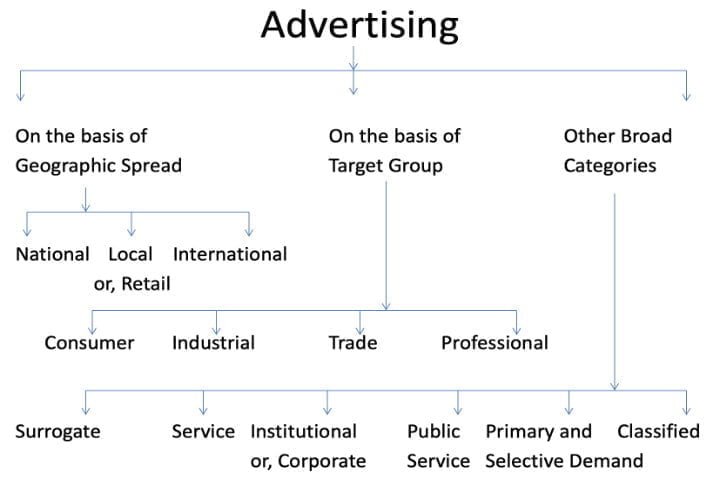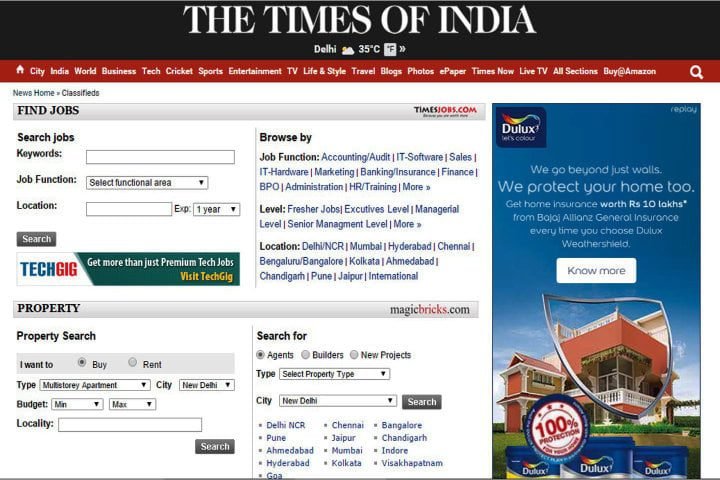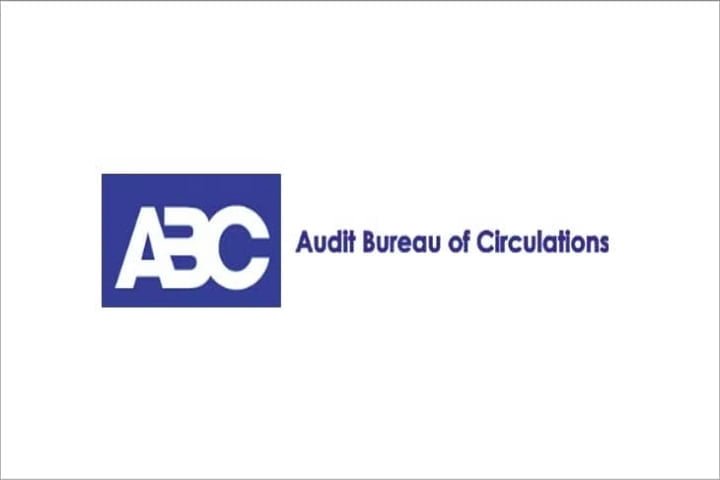Types of Advertising
In the first article of the advertising section of the CUET UG Mass Media and Communication, the advertising concept and process, along with its definition and functions of advertising, were discussed in detail. In this article, we are going to discuss the types of advertising.
In This Article
But before that, it is essential to understand the relationship between advertisers, advertising agencies, and media.
Advertisers are businesses that want to promote their products or services to buyers through mass media. Advertising agencies are the creative and strategic hubs responsible for crafting compelling narratives that resonate with consumers in their buying journey. Media comprises various platforms such as television, print, digital, and social media, serving as the medium through which the advertising messages are delivered to the target audience.
Advertisers provide advertising agencies with a clear understanding of their brand identity, consumer analysis, desired outcomes, etc., empowering them to develop strategic communication to maximize the reach and engagement with their target customers for driving growth and success in an increasingly competitive marketplace.
The advertiser’s ultimate aim is to create a brand out of their products. For example, Surf Excel is a laundry detergent brand owned by Hindustan Unilever Limited. But it is so popular that we use the name “Surf” instead of washing powder in our daily conversations. Another example is Xerox. In casual conversation, Xerox has become interchangeable with photocopy. However, it is a registered trademark of the American multinational Xerox Corporation.
A thorough understanding of the target market, the brand’s goals, and the particular advantages of each advertising medium serve as the basis for choosing the appropriate type of advertising.


National Advertising
National advertising is marketing carried out by a business across the nation or in the majority of its regions and aimed at the target consumer market.
The companies that sponsor these ads are generally referred to as national advertisers. Most advertisements for well-known brands on television or in other significant media are national advertising. Examples of national advertisers are Hyundai, Nestle, and HUL.
It informs or reminds consumers of the brand and its features, benefits, and advantages, as well as uses or reinforces its images. However, in the Indian context, advertisers release different versions of advertisements due to cultural and linguistic variations.


Local or Retail Advertising
Another prevalent type of advertising directed at the consumer market is classified as retail or local advertising.
Major retailers or smaller local merchants advertise to encourage consumers to shop at a specific store or use a local service, such as local financial companies, banks, hospitals, fitness clubs, restaurants, showrooms, etc.
While national advertisers sell their products at many locations, retail or local advertisers must give the consumer a reason to patronize their establishment.
Retail advertising highlights features that make a product stand out for the consumer, like merchandise collection, storehouse, credit policies, services, and atmosphere.


International Advertising
International advertising disseminates a commercial message to a target audience in more than one country and multiple cultures that differ in values, communication styles, and consumption patterns. Target audiences vary from country to country regarding how they perceive or interpret messages.
International advertising is a business activity involving advertisers and advertising agencies that create ads and buy media in different countries.
In some cases, multinational firms centralize advertising decisions and budgets and use the same or a limited number of agencies worldwide. In other cases, budgets are decentralized and placed in the hands of local subsidiaries, resulting in greater use of local advertising agencies.

Consumer Product Advertising


Consumer product advertising is an activity that makes products or services known as well as persuades the ultimate consumer. An ultimate consumer is a person who buys a product or service for personal use.
The manufacturer or dealer of the product or service does this type of advertising.
Industrial Advertising


Advertising targeted at individuals who buy or influence the purchase of industrial goods or other services is known as industrial advertising.
Industrial goods are those products that either become a physical part of another product or are used in manufacturing other goods.
Business services, such as insurance, financial services, and health care, are also included in this category. Industrial advertising is usually found in general business publications or trade publications targeted to a particular industry.
Trade Advertising


Advertising within a trade to attract wholesalers and retailers and motivate them to purchase its products for resale is termed trade advertising.
Company sales representatives call on resellers to explain the product, discuss the firm’s plans for building demand among ultimate consumers, and describe special programs offered to the trade, such as introductory discounts, promotional allowances, etc.
Trade advertising usually appears in publications that serve a particular industry.
Professional Advertising


Advertising that is targeted to professional groups, such as doctors, lawyers, dentists, and engineers, to encourage them to use the advertiser’s product or specify it for others to use is known as professional advertising.
Professional groups are important because they constitute a market for products and services they use in their businesses. Also, their recommendations influence many consumer purchase decisions.
Surrogate Advertising


Surrogate advertising is a form of advertising that is used to promote banned products, like cigarettes, alcohol, tobacco, and narcotics, in the disguise of another product.
The advent of surrogate advertising in India came after the Cable Television Networks Rules, 1994, and the Cable Television Networks (Regulation) Act, 1995, which banned direct liquor, tobacco, and cigarette advertisements.
The tobacco industry engaged in surrogate advertising in India includes the Red & White Bravery Awards, Wills Lifestyle Clothing Line, Four Square White Water Rafting, and Godfrey Phillips Bravery Awards.
Examples from the liquor industry are Bagpiper Soda, Cassettes & CDs, Hayward Soda, Royal Challenge Golf Accessories & Mineral Water, Kingfisher Mineral Water, White Mischief Holidays, Smirnoff Cassettes & CDs, Imperial Blue Cassettes & CDs, and Teacher’s Achievement Awards.
Corporate Advertising
In this form of advertising, the corporation presents its own story to build up a positive image in the public mind. It is a public relations approach to advertising. The focus point could be:
- Viewpoint about a national cause
- Efforts taken to help this cause
- Corporate social contribution and policies
- The mission of the organization and its philosophy
Corporate advertising is indirect and subtle, affecting the public’s basic attitudes and does not attempt to sell anything directly. It may be targeted to a potential market or any of the stakeholders. Many companies are faceless entities. This type of advertising gives a face to the company.

The objective of Corporate advertising is:
- To make the company known
- To make its products and services known
- To make its achievements known
- To make its values known
- To make socio-political/economic/moral statements
Receptivity to Corporate Advertising:
- They are meant to build images, so they are not considered necessary
- The public are usually adverse to this type of advertising
- It asks for no action on the part of the audience except passive approval
- The recall rates of these ads are low
- The effectiveness of these types of ads is difficult to evaluate.
Public Service Advertising


Public Service Advertising (PSA) is done as a part of social responsibility by advertising agencies, business organizations, or government or social service institutions.
Public service advertising is considered one of the most effective means of creating social awareness and bringing about a change/shift in people’s mindsets.
In PSA, it is essential to focus the message on a target group while keeping in mind what motivates this target group.
PSAs are usually emotional since they touch people’s deepest fears, anxieties and values.
It is also called Public Awareness Advertising, Social Service Advertising and Social Awareness Advertising.
Primary and Selective Demand Advertising


Primary Demand Advertising is designed to create demand for the general product class or entire industry.
Selective Demand Advertising focuses on creating demand for a particular manufacturer’s brands.
These are another way of viewing advertising to the ultimate customers regarding whether the message is designed to stimulate either primary or selective demand.
Primary demand advertising is often used as a promotional strategy to help a new product gain customer acceptance. Products in the introductory or growth stages of their life cycles usually have primary demand stimulation as a promotional objective because the challenge is to sell customers on the product as much as it is to sell a particular brand.
Classified Advertising


The ads that are classified into categories are called classified ads. These ads are typically placed in certain parts of the newspaper.
Classified advertising is a tool for reaching out to various categories of customers to offer jobs, cars, houses and various new and used goods.
In print, classified advertising space is sold in terms of lines or words.
On the internet, classified ads are posted free of charge, though they are chargeable for premium posting. For example, Justdial OLX, Quikr, etc.
NGO Advertising


There’s good advertising. Then there’s advertising that does some good. Advertising with a core aim to raise social issues and help improve the world is a motive of NGO advertising.
These main aims are advertising for good causes, promoting the importance of social and environmental responsibility, encouraging the participation of ordinary people, and urging them to donate to a cause.
Complicated narratives and long explanations don’t attract attention, and they don’t get donations; heartbreaking pictures and tidy stories do.
Financial Advertising


Financial advertising is the specialized practice of advertising that promotes capital issues to investors, loan, banking, and mortgage customers.
Increased wealth and expectations have created an enormous appetite for financial services, and new financial products are launched daily. So, it is necessary to pinpoint a product’s potential and identity and identify the audience to whom it will appeal.
The public is motivated to invest by a slogan, a promise of dividends/returns, the profile of the product, etc.
The positive image of a financial corporation is primarily promoted to turn it into a trusted name for general investors.
The CUET UG 2024 Mass Media and Communication syllabus under the Advertising section contains this topic.




